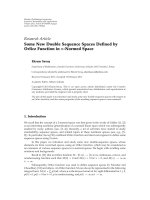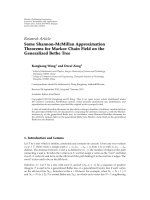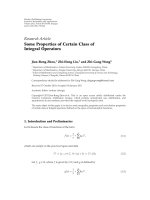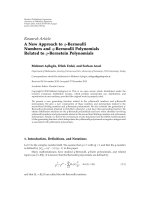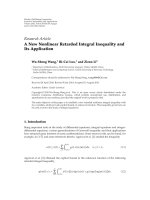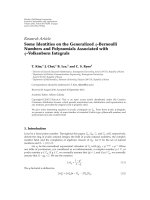Báo cáo hóa học: " Research Article Some New Double Sequence Spaces Defined by Orlicz Function in n-Normed Space" docx
Bạn đang xem bản rút gọn của tài liệu. Xem và tải ngay bản đầy đủ của tài liệu tại đây (492.63 KB, 9 trang )
Hindawi Publishing Corporation
Journal of Inequalities and Applications
Volume 2011, Article ID 592840, 9 pages
doi:10.1155/2011/592840
Research Article
Some New Double Sequence Spaces Defined by
Orlicz Function in n-Normed Space
Ekrem Savas¸
Department of Mathematics, Istanbul Commerce University, Uskudar, 34672 Istanbul, Turkey
Correspondence should be addressed to Ekrem Savas¸,
Received 1 January 2011; Accepted 17 February 2011
Academic Editor: Alberto Cabada
Copyright q 2011 Ekrem Savas¸. This is an open access article distributed under the Creative
Commons Attribution License, which permits unrestricted use, distribution, and reproduction in
any medium, provided the original work is properly cited.
The aim of this paper is to introduce and study some new double sequence spaces with respect to
an Orlicz function, and also some properties of the resulting sequence spaces were examined.
1. Introduction
We recall that the concept of a 2-normed space was first given in the works of G
¨
ahler 1, 2
as an interesting nonlinear generalization of a normed linear space which was subsequently
studied by many authors see, 3, 4. Recently, a lot of activities have started to study
summability, sequence spaces, and related topics in these nonlinear spaces see, e.g., 5–
9.Inparticular,Savas¸ 10 combined Orlicz function and ideal convergence to define some
sequence spaces using 2-norm.
In this paper, we introduce and study some new double-sequence spaces, whose
elements are form n-normed spaces, using an Orlicz function, which may be considered as
an extension of various sequence spaces to n-normed spaces. We begin with recalling some
notations and backgrounds.
Recall in 11 that an Orlicz function M : 0, ∞ → 0, ∞ is continuous, convex, and
nondecreasing function such that M00andMx > 0forx>0, and Mx →∞as
x →∞.
Subsequently, Orlicz function was used to define sequence spaces by Parashar and
Choudhary 12 and others. An Orlicz function M can always be represented in the following
integral form: Mx
x
0
ptdt,wherep is the known kernel of M, right differential for t ≥ 0,
p00, pt > 0fort>0, p is nondecreasing, and pt →∞as t →∞.
2 Journal of Inequalities and Applications
If convexity of Orlicz function M is replaced by Mx y ≤ MxMy, then this
function is called Modulus function, which was presented and discussed by Ruckle 13 and
Maddox 14.
Remark 1.1. If M is a convex function and M00, then Mλx ≤ λMx for all λ with
0 <λ<1.
Let n ∈
and X be real vector space of dimension d,wheren ≤ d.Ann-norm on X is
afunction·, ,· : X × X ×···×X →
which satisfies the following four conditions:
i x
1
,x
2
, ,x
n
0 if and only if x
1
,x
2
, ,x
n
are linearly dependent,
ii x
1
,x
2
, ,x
n
are invariant under permutation,
iii αx
1
,x
2
, ,x
n
|α|x
1
,x
2
, ,x
n
, α ∈ ,
iv x x
,x
2
, ,x
n
≤x, x
2
, ,x
n
x
,x
2
, ,x
n
.
The pair X, ·, ,· is then called an n-normed space 3.
Let X
d
d ≤ n be equipped with the n-norm, then x
1
,x
2
, ,x
n−1
,x
n
S
: the
volume of the n-dimensional parallelepiped spanned by the vectors, x
1
,x
2
, ,x
n−1
,x
n
which
may be given explicitly by the formula
x
1
,x
2
, ,x
n−1
,x
n
S
x
1
,x
2
···
x
1
,x
n
.
. ···
.
x
n
,x
1
···
x
n
,x
n
1/2
,
1.1
where ·, · denotes inner product. Let X, ·, ,· be an n-normed space of dimension d ≥
n and {a
1
,a
2
, ,a
n
} a linearly independent set in X. Then, the function ·, ·
∞
on X
n−1
is
defined by
x
1
,x
2
, ,x
n−1
,x
n
∞
: max
{
x
1
,x
2
, ,x
n−1
,a
i
: i 1, 2, ,n
}
, 1.2
is defines an n − 1 norm on X with respect to {a
1
,a
2
, ,a
n
} see, 15.
Definition 1.2 see 7.Asequencex
k
in n-normed space X, ·, ,· is aid to be
convergent to an x in X in the n-norm if
lim
k →∞
x
1
,x
2
, ,x
n−1
,x
k
− x
0,
1.3
for every x
1
,x
2
, ,x
n−1
∈ X.
Definition 1.3 see 16.LetX be a linear space. Then, a map g : X →
is called a paranorm
on X if it is satisfies the following conditions for all x, y ∈ X and λ scalar:
i gθ0 θ 0, 0, ,0 is zero of the space,
Journal of Inequalities and Applications 3
ii gxg−x,
iii gx y ≤ gxgy,
iv |λ
n
− λ|→0 n →∞ and gx
n
− x → 0 n →∞ imply gλ
n
x
n
− λx → 0 n →
∞.
2. Main Results
Let X, ·, ,· be any n-normed space, a nd let S
n − X denote X-valued sequence spaces.
Clearly S
n − X is a linear space under addition and scalar multiplication.
Definition 2.1. Let M be an Orlicz function and X, ·, ,· any n-normedspace.Further,let
p p
k,l
be a bounded sequence of positive real numbers. Now, we define the following new
double sequence space as follows:
l
M, p,
·, ,·
:
x ∈ S
n − X
:
∞,∞
k,l1
M
x
k,l
ρ
,z
1
,z
2
, ,z
n−1
p
k,l
< ∞,ρ>0
,
2.1
for each z
1
,z
2
, ,z
n−1
∈ X.
The following inequalities will be used throughout the paper. Let p p
k,l
be a double
sequence of positive real numbers with 0 <p
k,l
≤ sup
k,l
p
k,l
H,andletD max{1, 2
H−1
}.
Then, for the factorable sequences {a
k
} and {b
k
} in the complex plane, we have as in Maddox
16
|
a
k,l
b
k,l
|
p
k,l
≤ D
|
a
k,l
|
p
k,l
|
b
k,l
|
p
k,l
. 2.2
Theorem 2.2. l
M, p, ·, ,· sequences space is a linear space.
Proof. Now, assume that x, y ∈ l
M, p, ·, ,· and α, β ∈ . Then,
∞,∞
k,l1
M
x
k,l
ρ
1
,z
1
,z
2
, ,z
n−1
p
k,l
< ∞ for some ρ
1
> 0,
∞,∞
k,l1,1
M
x
k,l
ρ
2
,z
1
,z
2
, ,z
n−1
p
k,l
< ∞ for some ρ
2
> 0.
2.3
4 Journal of Inequalities and Applications
Since ·, ,· is a n-norm on X,andM is an Orlicz function, we get
∞,∞
k,l1,1
M
αx
k,l
βy
k,l
max
|
α
|
ρ
1
,
β
ρ
2
,z
1
,z
2
, ,z
n−1
p
k,l
≤ D
∞,∞
k,l1,1
|
α
|
|
α
|
ρ
1
β
ρ
2
M
x
k,l
ρ
1
,z
1
,z
2
, ,z
n−1
p
k,l
D
∞
k,l1,1
β
|
α
|
ρ
1
β
ρ
2
M
y
k,l
ρ
2
,z
1
,z
2
, ,z
n−1
p
k,l
≤ DF
∞,∞
k,l1,1
M
x
k,l
ρ
1
,z
1
,z
2
, ,z
n−1
p
k,l
DF
∞
k,l1,1
M
y
k,l
ρ
2
,z
1
,z
2
, ,z
n−1
p
k,l
,
2.4
where
F max
⎡
⎣
1,
|
α
|
|
α
|
ρ
1
β
ρ
2
H
,
β
|
α
|
ρ
1
β
ρ
2
H
⎤
⎦
, 2.5
and this completes the proof.
Theorem 2.3. l
M, p, ·, ,· space is a paranormed space with the paranorm defined by g :
l
M, p, ·, ,· →
g
x
inf
⎧
⎨
⎩
ρ
p
k,l
/H
:
∞
k,l1,1
M
x
k,l
ρ
,z
1
,z
2
, ,z
n−1
p
k,l
1/M
∗
< ∞
⎫
⎬
⎭
, 2.6
where 0 <p
k,l
≤ sup p
k,l
H, M
∗
max1 ,H.
Proof. i Clearly, gθ0andii g−xgx. iii Let x
k,l
,y
k,l
∈ l
M, p, ·, ,·,then
there exists ρ
1
,ρ
2
> 0suchthat
∞,∞
k,l1,1
M
x
k,l
ρ
1
,z
1
,z
2
, ,z
n−1
p
k,l
< ∞,
∞,∞
k,l1,1
M
y
k,l
ρ
2
,z
1
,z
2
, ,z
n−1
p
k,l
< ∞.
2.7
Journal of Inequalities and Applications 5
So, we have
M
x
k,l
y
k,l
ρ
1
ρ
2
,z
1
,z
2
, ,z
n−1
≤ M
x
k,l
ρ
1
ρ
2
,z
1
,z
2
, ,z
n−1
y
k,l
ρ
1
ρ
2
,z
1
,z
2
, ,z
n−1
≤
ρ
1
ρ
1
ρ
2
M
x
k,l
ρ
1
,z
1
,z
2
, ,z
n−1
ρ
1
ρ
1
ρ
2
M
y
k,l
ρ
2
,z
1
,z
2
, ,z
n−1
,
2.8
and thus
g
x y
inf
⎧
⎨
⎩
ρ
1
ρ
2
p
k,l
/H
:
∞
k,l1,1
M
x
k,l
y
k,l
ρ
1
ρ
2
,z
1
, z
2
, ,z
n−1
p
k,l
1/M
∗
⎫
⎬
⎭
≤ inf
⎧
⎨
⎩
ρ
1
p
k,l
/H
:
∞
k,l1,1
M
x
k,l
ρ
1
,z
1
,z
2
, ,z
n−1
p
k,l
1/M
∗
⎫
⎬
⎭
inf
⎧
⎨
⎩
ρ
2
p
k,l
/H
:
∞
k1
M
y
k,l
ρ
2
,z
1
,z
2
, ,z
n−1
p
k,l
1/M
∗
⎫
⎬
⎭
.
2.9
iv Now, let λ → 0andgx
n
− x → 0 n →∞.Since
g
λx
inf
⎧
⎨
⎩
ρ
|
λ
|
p
k,l
/H
:
∞
k,l1,1
M
λx
k,l
ρ
,z
1
,z
2
, ,z
n−1
p
k,l
1/M
∗
< ∞
⎫
⎬
⎭
.
2.10
This gives us gλx
n
→ 0 n →∞.
Theorem 2.4. If 0 <p
k,l
<q
k,l
< ∞ for each k and l,thenl
M, p, ·, ,· ⊆ l
M, q, ·, ,·.
Proof. If x ∈ l
M, p, ·, ,·, then there exists some ρ>0suchthat
∞,∞
k,l1,1
M
x
k,l
ρ
,z
1
,z
2
, ,z
n−1
p
k,l
< ∞.
2.11
This implies that
M
x
k,l
ρ
,z
1
,z
2
, ,z
n−1
< 1,
2.12
6 Journal of Inequalities and Applications
for sufficiently large values of k and l.SinceM is nondecreasing, we are granted
∞,∞
k,l1,1
M
x
k,l
ρ
,z
1
,z
2
, ,z
n−1
q
k,l
≤
∞,∞
k,l1,1
M
x
k,l
ρ
,z
1
,z
2
, ,z
n−1
p
k,l
< ∞.
2.13
Thus, x ∈ l
M, q, ·, ,·. This completes the proof.
The following result is a consequence of the above theorem.
Corollary 2.5. i If 0 <p
k,l
< 1 for each k and l,then
l
M, p,
·, ,·
⊆ l
M,
·, ,·
, 2.14
ii If p
k,l
≥ 1 for each k and l,then
l
M,
·, ,·
⊆ l
M, p,
·, ,·
. 2.15
Theorem 2.6. u u
k,l
∈ l
∞
⇒ ux ∈ l
M, p, ·, ,·,wherel
∞
isthedoublespaceofbounded
sequences and ux u
k,l
x
k,l
.
Proof. u u
k,l
∈ l
∞
. Then, there exists an A>1suchthat|u
k,l
|≤A for each k, l.Wewantto
show u
k,l
x
k,l
∈ l
M, p, ·, ,·.But
∞,∞
k,l1,1
M
u
k,l
x
k,l
ρ
,z
1
,z
2
, ,z
n−2
,z
n−1
p
k,l
∞,∞
k,l1,1
M
|
u
k,l
|
x
k,l
ρ
,z
1
,z
2
, ,z
n−2
,z
n−1
p
k,l
≤
KA
H
∞
k,l1,1
M
x
k,l
ρ
,z
1
,z
2
, ,z
n−2
,z
n−1
p
k,l
,
2.16
and this completes the proof.
Theorem 2.7. Let M
1
and M
2
be Orlicz function. Then, we have
l
M
1
,p,
·, ,·
l
M
2
,p,
·, ,·
⊆ l
M
1
M
2
,p,
·, ,·
. 2.17
Journal of Inequalities and Applications 7
Proof. We have
M
1
M
2
x
k,l
ρ
,z
1
,z
2
, ,z
n−1
p
k,l
M
1
x
k,l
ρ
,z
1
,z
2
, ,z
n−1
M
2
x
k,l
ρ
,z
1
,z
2
, ,z
n−1
p
k,l
≤ D
M
1
x
k,l
ρ
,z
1
,z
2
, ,z
n−1
p
k,l
D
M
2
x
k,l
ρ
,z
1
,z
2
, ,z
n−1
p
k,l
.
2.18
Let x ∈ l
M
1
,p,·, ,·
l
M
2
,p,·, ,·; when adding the above inequality from k, l
0, 0to∞, ∞ we get x ∈ l
”
M
1
M
2
,p,·, ,· and this completes the proof.
Definition 2 .8 see 10.LetX be a sequence space. Then, X is called solid if α
k
x
k
∈ X
whenever x
k
∈ X for all sequences α
k
of scalars with |α
k
|≤1forallk ∈ .
Definition 2.9. Let X be a sequence space. Then, X is called monotone if it contains the
canonical preimages of all its step spaces see, 17.
Theorem 2.10. The sequence space l
M, p, ·, ,· is solid.
Proof. Let x
k,l
∈ l
M, p, ·, ,·;thatis,
∞,∞
k,l1,1
M
x
k,l
ρ
,z
1
,z
2
, ,z
n−1
p
k,l
< ∞. 2.19
Let α
k,l
be double sequence of scalars such that |α
k,l
|≤1forallk, l ∈ × . Then, the result
follows from the following inequality:
∞,∞
k,l1,1
M
α
k,l
x
k,l
ρ
,z
1
,z
2
, ,z
n−1
p
k,l
≤
∞,∞
k,l1,1
M
x
k,l
ρ
,z
1
,z
2
, ,z
n−1
p
k,l
, 2.20
and this completes the proof.
We have the following result in view of Remark 1.1 and Theorem 2.10.
Corollary 2.11. The sequence space l
M, p, ·, ,· is monotone.
Definition 2.12 see 18.LetA a
m,n,k,l
denote a four-dimensional summability method
that maps the complex double sequences x into the double-sequence Ax,wherethemnth
term to Ax is as follows:
Ax
m,n
∞,∞
k,l1,1
a
m,n,k,l
x
k,l
. 2.21
Such transformation is said to be nonnegative if a
m,n,k,l
is nonnegative for all m, n, k,
and l.
8 Journal of Inequalities and Applications
Definition 2.13. Let A a
m,n,k,l
be a nonnegative matrix. Let M be an Orlicz function and p
k,l
a factorable double sequence of strictly positive real numbers. Then, we define the following
sequence spaces:
ω
0
M, A, p,
·, ,·
x ∈ S
n − 1
: lim
m,n →∞,∞
∞,∞
k,l1,1
M
a
m,n,k,l
x
k,l
ρ
,z
1
,z
2
, ,z
n−2
,z
n−1
p
k,l
0
.
2.22
for each z
1
,z
2
, ,z
n−1
∈ X.Ifx − le ∈ ω
0
M, A, p, ·, ,·,thenwesayx is ω
0
M, A,
p, ·, ,· summable to l,wheree 1, 1, .
If we take Mxx and p
k,l
1forallk, l,thenwehave
ω
0
A, p,
·, ,·
x ∈ S
n − 1
: lim
m,n →∞
∞,∞
k,l1,1
a
m,n,k,l
x
k,l
,z
1
,z
2
, ,z
n−2
,z
n−1
0
.
2.23
Theorem 2.14. ω
0
M, A, p, ·, ,· is linear spaces.
Proof. This can be proved by using the techniques similar to those used in Theorem 2.2.
Theorem 2.15. 1 If 0 < inf p
k,l
≤ p
k,l
< 1,then
ω
0
M, A, p,
·, ,·
⊂ ω
0
M, A,
·, ,·
. 2.24
2 If 1 ≤ p
k,l
≤ sup p
k,l
< ∞,then
ω
0
M, A,
·, ,·
⊂ ω
0
M, A, p,
·, ,·
. 2.25
Proof. 1 Let x ∈ ω
0
M, A, p, ·, ,·;since0< inf p
k,l
≤ 1, we have
∞,∞
k,l1,1
M
a
m,n,k,l
x
k,l
ρ
,z
1
,z
2
, ,z
n−2
,z
n−1
≤
∞,∞
k,l1
M
a
m,n,k,l
x
k
ρ
,z
1
,z
2
, ,z
n−2
,z
n−1
p
k,l
,
2.26
and hence x ∈ ω
0
M, A, ·, ,·.
2 Let p
k,l
≥ 1foreachk, l and sup
k,l
p
k,l
< ∞.Letx ∈ ω
0
M, A, ·, ,·.
Then, for each 0 <<1, there exists a positive integer
such that
∞,∞
k,l1,1
M
a
m,n,k,l
x
k,l
ρ
,z
1
,z
2
, ,z
n−2
,z
n−1
≤ <1, 2.27
Journal of Inequalities and Applications 9
for all m, n ≥
. This implies that
∞,∞
k,l1,1
M
a
m,n,k,l
x
k,l
ρ
,z
1
,z
2
, ,z
n−2
,z
n−1
p
k,l
≤
∞
k,l1
M
a
m,n,k,l
x
k,l
ρ
,z
1
,z
2
, ,z
n−2
,z
n−1
.
2.28
Thus, x ∈ ω
0
M, A, p, ·, ,·, and this completes the proof.
Acknowledgments
The author wishes to thank the referees for their careful reading of the paper and for their
helpful suggestions.
References
1 S. G
¨
ahler, “Lineare 2-normierte R
¨
aume,” Mathematische Nachrichten, vol. 28, pp. 1–43, 1965.
2 S. G
¨
ahler, “
¨
Uber die Uniformisierbarkeit 2-metrischer R
¨
aume,” Mathematische Nachrichten, vol. 28, pp.
235–244, 1965.
3 H. Gunawan, “The space of p-summable sequences and its natural n-norm,” Bulletin of the Australian
Mathematical Society, vol. 64, no. 1, pp. 137–147, 2001.
4 R. W. Freese and Y. J. Cho, Geometry of Linear 2-Normed Spaces, Nova Science Publishers, Hauppauge,
NY, USA, 2001.
5 A. S¸ahiner, M. G
¨
urdal, S. Saltan, and H. Gunawan, “Ideal convergence in 2-normed spaces,” Taiwanese
Journal of Mathematics, vol. 11, no. 5, pp. 1477–1484, 2007.
6 M. G
¨
urdal and S. Pehlivan, “Statistical convergence in 2-normed spaces,” Southeast Asian Bulletin of
Mathematics, vol. 33, no. 2, pp. 257–264, 2009.
7 H. Gunawan and M. Mashadi, “On n-normed spaces,” International Journal of Mathematics and
Mathematical Sciences, vol. 27, no. 10, pp. 631–639, 2001.
8 A. Sahiner and M. Gurdal, “New sequence spaces in n-normed spaces with respect to an Orlicz
function,” The Aligarh Bulletin of Mathematics, vol. 27, no. 1, pp. 53–58, 2008.
9 E. Savas¸, “On some new sequence spaces in 2-normed spaces using ideal convergence and an Orlicz
function,” journal of Inequalities and Applications, vol. 2010, Article ID 482392, 8 pages, 2010.
10 E. Savas¸, “Δ
m
-strongly summable sequences spaces in 2-normed spaces defined by ideal convergence
and an Orlicz function,” Applied Mathematics and Computation, vol. 217, no. 1, pp. 271–276, 2010.
11 M. A. Krasnoselski and Y. B. Rutisky, Convex Function and Orlicz Spaces, Noordhoff, Groningen, The
Netherlands, 1961.
12 S. D. Parashar and B. Choudhary, “Sequence spaces defined by Orlicz functions,” Indian Journal of
Pure and Applied Mathematics, vol. 25, no. 4, pp. 419–428, 1994.
13 W. H. Ruckle, “FK spaces in which the sequence of coordinate vectors is bounded,” Canadian Journal
of Mathematics. Journal Canadien de Math
´
ematiques, vol. 25, pp. 973–978, 1973.
14 I. J. Maddox, “Sequence spaces defined by a modulus,” Mathematical Proceedings of the Cambridge
Philosophical Society, vol. 100, no. 1, pp. 161–166, 1986.
15 H. Gunawan, “On n-inner products, n-norms, and the Cauchy-Schwarz inequality,” Scientiae
Mathematicae Japonicae, vol. 55, no. 1, pp. 53–60, 2002.
16 I. J. Maddox, Elements of Functional Analysis, Cambridge University Press, London, UK, 1970.
17 P. K. Kampthan and M. Gupta, Sequence Spaces and Series,vol.65ofLectur e Notes in Pure and Applied
Mmathematics, Marcel Dekker, New York, NY, USA, 1981.
18 E. Savas and R. F. Patterson, “On some double sequence spaces defined by a modulus,” Math. Slovaca,
vol. 61, no. 2, pp. 1–12, 2011.
